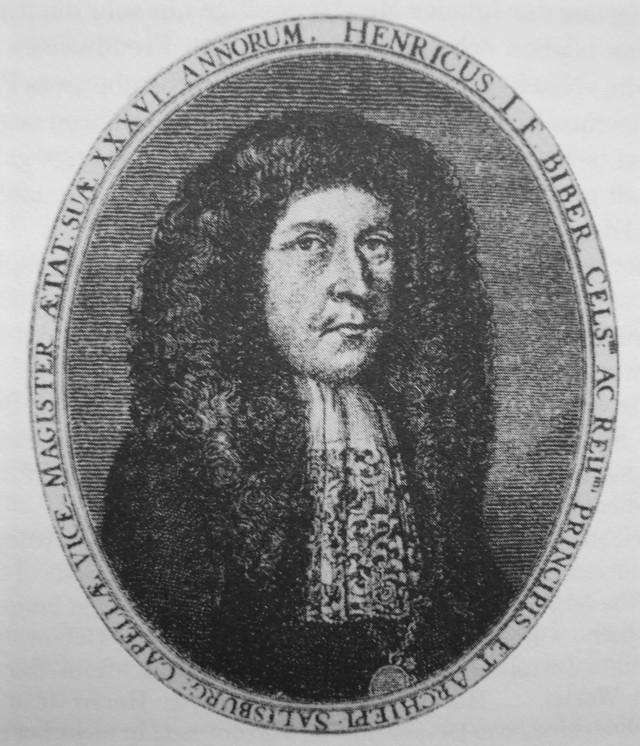Heinrich Ignaz Franz von Biber
 AUTClassical, Chamber Music
AUTClassical, Chamber Music

 AUTClassical, Chamber Music
AUTClassical, Chamber MusicHeinrich Ignaz Franz von Biber was a notable composer from Austria, known for his contributions to classical music, particularly in the realm of chamber music. He lived during the late 17th century and is often celebrated for his innovative use of string instruments. Biber's works showcase a unique blend of melody and harmony, reflecting the rich musical traditions of his time. His compositions, including sonatas and partitas, continue to be appreciated for their creativity and depth, making him a significant figure in the baroque music scene.
Heinrich Ignaz Franz von Biber's music showcases rich textures and intricate structures. One standout piece is “Violin Sonata No. 11 in G Major, C. 100, 'The Resurrection' (from 'The Glorious Mysteries'): III. Adagio.” This sonata captures a contemplative mood, inviting listeners to reflect. Another engaging work is “Violin Sonata No. 3 in F Major, C. 140: V. Variatio,” which features variations that reveal Biber's skill in transforming themes while maintaining a cohesive sound.
Other notable tracks include “Violin Sonata No. 6 in C Minor, C. 143: IV. Gavotta,” and “Violin Sonata No. 1 in A Major, C. 138: I. [...]” Each piece contributes to Biber's reputation in chamber music. “Violin Sonata No. 5 in E Minor, C. 142: II. Variatio - Allegro” and “Violin Sonata violino solo representativa in A Major, C. 146: II. Die Nachtigal” also highlight his creativity. These selections reflect a blend of technical mastery and emotional depth, making Biber's work an important part of classical music.
Heinrich Ignaz Franz von Biber’s recent works reflect a blend of historical significance and contemporary appeal. The latest album, "Just Biber (2025)," showcases a selection of his compositions, drawing attention to his innovative approach to violin music. Another notable release is "Biber: Complete Violin Sonatas — 1681 (2025)," which offers a comprehensive look at his sonatas, while "Adagio" - Smooth Music to Relax (2025) presents a more tranquil interpretation of his style.
Among the singles, "Sonatæ Violino solo '1681': Sonata No. 7 in G Major, C. 144: III. Adagio (2025)" stands out, providing a glimpse into his melodic intricacies. "Mensa sonora, Pars III in A Minor, C.71: IV. Ciacona (2025)" explores rhythmic variations, while "Biber: Violin Sonata No. 1 in A Major, C. 138: I. [...] (2025)" highlights his structural finesse. Additionally, "Sonatæ Violino solo '1681': Sonata No. 2 in D Dorian Mode, C. 139: II. Aria (2025)" underscores his capability to blend emotion with technique. These recent releases illustrate Biber's enduring legacy in classical and chamber music.
Heinrich Ignaz Franz von Biber's music has found its way to various significant venues and festivals over the years. One notable performance took place at the Muziekgebouw aan 't IJ, where his baroque compositions resonated well with the audience, showcasing the intricate interplay of strings that characterize his work.
Other performances include appearances at the Festival van Vlaanderen and early music festivals across Europe. Each event highlighted Biber's unique approach to violin and chamber music, attracting both seasoned listeners and newcomers alike. While some performances focused on his most famous works, others explored lesser-known pieces, providing a comprehensive view of his catalog.
These events contribute to a deeper appreciation of Biber’s influence in the classical music scene, allowing audiences to engage with his complex compositions in various settings.
Heinrich Ignaz Franz von Biber’s collaborations showcase a blend of traditional and contemporary interpretations of his work. The track “Violin Sonata No. 3 in F Major, C. 140: V. Variatio,” performed by Rachel Podger and Brecon Baroque, highlights the intricate interplay of violin and ensemble, drawing listeners into Biber’s unique musical language. Similarly, “Violin Sonata violino solo representativa in A Major, C. 146: II. Die Nachtigal,” also featuring Podger and Brecon Baroque, offers a captivating exploration of thematic variation, emphasizing the expressive capabilities of the violin.
Another notable collaboration is the performance of “Sonatæ Violino solo '1681': Sonata No. 3 in F Major, C. 140: III. Presto – Adagio – Allegro – Adagio” by Bojan Čičić and The Illyria Consort. This piece reflects Biber’s skill in shifting musical moods and tempos. Ensemble Castelkorn and Josef Žák take on “Ciacona for Violin and Basso Continuo,” showcasing a different facet of Biber’s work, focusing on the dialogue between violin and continuo. Each collaboration presents a fresh perspective on Biber’s compositions, inviting deeper appreciation for his contributions to chamber music.